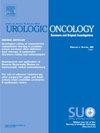ARE WOMEN UNDERREPRESENTED IN UROLOGIC ONCOLOGY CLINICAL TRIALS?
IF 2.4
3区 医学
Q3 ONCOLOGY
Urologic Oncology-seminars and Original Investigations
Pub Date : 2025-03-01
DOI:10.1016/j.urolonc.2024.12.024
引用次数: 0
Abstract
Introduction
Clinical trials should reflect the population affected by the disease under study. While urologic cancers occur more frequently in men, there is still a significant incidence in women. Whether women are proportionately represented in urologic oncology clinical trials is not known. Ensuring representative enrollment is crucial for the generalizability of trial outcomes and addressing potential gender disparities in treatment efficacy and safety. This analysis examines enrollment of women in urologic oncology clinical trials compared to the estimated incidence of these cancers among women.
Methods
Enrollment demographics were extracted from the Aggregate Analysis of ClinicalTrials.gov database for bladder and kidney cancer trials registered since 1/1/2007. Trials with results reported were included. The proportion of female enrollees in each trial was calculated from aggregate result tables. Trials were then coded by cancer type, and descriptive statistics were calculated for proportion of women enrolled for trials of each cancer type. These proportions were compared to the proportion of incident cancers estimated by the American Cancer Society.
Results
There were 590 cancer trials included in the analysis, with 414 kidney and 176 bladder trials. The median proportion of women in kidney cancer trials was 29% (IQR 23-37%), with a mean of 31%. The expected proportion based on estimated proportional incidence of kidney cancer in women is 36%. Among bladder cancer trials, the median proportion of women was 22% (IQR 16-30%), with a mean of 25%, which is similar to the estimated proportional incidence of bladder cancer in women (24%).
Conclusions
The proportion of women enrolled in kidney cancer clinical trials is below what is expected based on annual incident proportions, falling short by approximately 1 in 14 women with kidney cancer. Meanwhile, bladder cancer trials enrolled the expected proportion of women with bladder cancer. Further work is needed to ensure adequate representation of women in kidney cancer trials, especially for advanced and metastatic settings. While women are not currently underserved in bladder cancer trials, efforts should continue to maintain representative enrollment of women to ensure equitable and effective urologic cancer treatment across sexes and genders.
女性在泌尿肿瘤临床试验中的代表性不足吗?
临床试验应反映受研究疾病影响的人群。虽然泌尿系统癌症在男性中更常见,但在女性中仍有显著的发病率。女性在泌尿肿瘤临床试验中的比例尚不清楚。确保有代表性的入组对于试验结果的普遍性和解决治疗有效性和安全性方面潜在的性别差异至关重要。本分析将纳入泌尿肿瘤临床试验的女性与这些癌症在女性中的估计发病率进行比较。方法从2007年1月1日以来注册的膀胱癌和肾癌试验的Aggregate Analysis of ClinicalTrials.gov数据库中提取统计数据。纳入已报告结果的试验。每个试验中女性入组者的比例由汇总结果表计算。然后根据癌症类型对试验进行编码,并对每种癌症类型的试验中登记的女性比例进行描述性统计。这些比例与美国癌症协会估计的癌症发病率进行了比较。结果共有590项癌症试验纳入分析,其中414项为肾脏试验,176项为膀胱试验。女性在肾癌试验中的中位比例为29% (IQR 23-37%),平均值为31%。根据估计的女性肾癌比例发病率,预期比例为36%。在膀胱癌试验中,女性比例中位数为22% (IQR 16-30%),平均值为25%,这与估计的女性膀胱癌比例发病率(24%)相似。结论:参加肾癌临床试验的女性比例低于基于年发病率的预期,低于约1 / 14的肾癌女性患者。同时,膀胱癌试验招募了预期比例的膀胱癌女性患者。需要进一步的工作来确保妇女在肾癌试验中有足够的代表性,特别是在晚期和转移性肾癌试验中。虽然目前女性在膀胱癌试验中的服务并不不足,但应继续努力保持有代表性的女性入组,以确保男女平等和有效的泌尿系统癌症治疗。
本文章由计算机程序翻译,如有差异,请以英文原文为准。
求助全文
约1分钟内获得全文
求助全文
来源期刊
CiteScore
4.80
自引率
3.70%
发文量
297
审稿时长
7.6 weeks
期刊介绍:
Urologic Oncology: Seminars and Original Investigations is the official journal of the Society of Urologic Oncology. The journal publishes practical, timely, and relevant clinical and basic science research articles which address any aspect of urologic oncology. Each issue comprises original research, news and topics, survey articles providing short commentaries on other important articles in the urologic oncology literature, and reviews including an in-depth Seminar examining a specific clinical dilemma. The journal periodically publishes supplement issues devoted to areas of current interest to the urologic oncology community. Articles published are of interest to researchers and the clinicians involved in the practice of urologic oncology including urologists, oncologists, and radiologists.

 求助内容:
求助内容: 应助结果提醒方式:
应助结果提醒方式:


